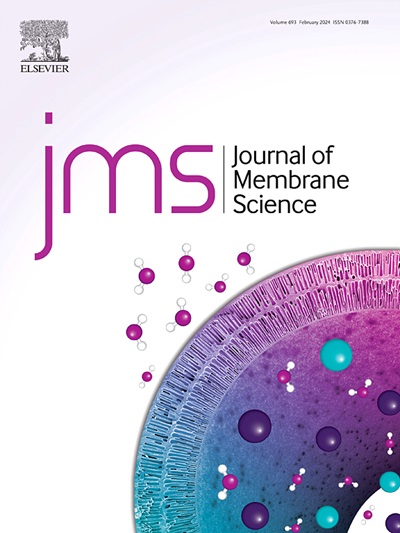Novel poly(ester amide) nanofiltration membranes fabricated utilizing 4-hydroxypiperidine as a co-reactive monomer for monovalent/divalent anionic salt separation
IF 8.4
1区 工程技术
Q1 ENGINEERING, CHEMICAL
引用次数: 0
Abstract
The thin-film composite (TFC) nanofiltration (NF) membranes are extremely promising in the field of monovalent/divalent anionic salt separation. The selection of monomers with different reactive groups could enable the TFC NF membranes to be more suitable for monovalent/divalent anionic salt separation. In this study, a novel low-cost compound 4-hydroxypiperidine (HDP) was first utilized with piperazine (PIP) as an aqueous phase co-reactive monomer to fabricate poly (ester amide) (PEA) TFC NF membranes via interfacial polymerization. The addition of HDP made the PEA layer thinner, smoother, and more hydrophilic while also creating larger pores and increasing the surface negative charge density. The water permeance of the optimal membrane NF–1P1H (with a PIP: HDP ratio of 1:1) was 13.67 L·m−2·h−1·bar−1, which was 70.24 % higher than that of NF–P (with a PIP: HDP ratio of 1:0). The NaCl/Na2SO4 separation factor of NF–1P1H was 43.00, which was 73.39 % higher than that of NF–P. NF–1P1H also had excellent selectivity in the mixed salt solution. In addition, NF–1P1H demonstrated superior operational stability, anti-fouling performance, chlorine resistance, and sufficient pH stability after short-term acid-base immersion. Moreover, the water permeance of NF–1P2H (with a PIP: HDP ratio of 1:2) could reach 15.08L·m−2·h−1·bar−1, which was 87.80 % higher than that of NF–P, and its separation factor was maintained at 27.12. This study presents a straightforward and efficient method for fabricating PEA TFC NF membranes with desirable water permeance and monovalent/divalent anionic salt separation performance.

以4-羟基哌替啶为共反应单体制备一价/二价阴离子盐分离的新型聚(酯酰胺)纳滤膜
薄膜复合纳滤膜(TFC)在一价/二价阴离子盐分离领域具有广阔的应用前景。选择具有不同反应基团的单体可以使TFC滤膜更适合于一价/二价阴离子盐的分离。在本研究中,首次将一种新型低成本化合物4-羟基哌啶(HDP)与哌嗪(PIP)作为水相共反应单体,通过界面聚合制备了聚酯酰胺(PEA) TFC NF膜。HDP的加入使PEA层更薄、更光滑、更亲水,同时也产生了更大的孔隙,增加了表面负电荷密度。最佳膜NF-1P1H (PIP: HDP比为1:1)的水透性为13.67 L·m−2·h−1·bar−1,比NF-P (PIP: HDP比为1:0)的水透性提高70.24%。NF-1P1H的NaCl/Na2SO4分离系数为43.00,比NF-P高73.39%。NF-1P1H在混合盐溶液中也有很好的选择性。此外,NF-1P1H在短期酸碱浸泡后表现出优异的操作稳定性、抗污性能、抗氯性能和足够的pH稳定性。此外,NF-1P2H (PIP: HDP比为1:2)的透水性可达15.08L·m−2·h−1·bar−1,比NF-P提高了87.80%,其分离系数保持在27.12。本研究提出了一种简单有效的方法来制备具有良好的透水性和一价/二价阴离子盐分离性能的PEA TFC NF膜。
本文章由计算机程序翻译,如有差异,请以英文原文为准。
求助全文
约1分钟内获得全文
求助全文
来源期刊

Journal of Membrane Science
工程技术-高分子科学
CiteScore
17.10
自引率
17.90%
发文量
1031
审稿时长
2.5 months
期刊介绍:
The Journal of Membrane Science is a publication that focuses on membrane systems and is aimed at academic and industrial chemists, chemical engineers, materials scientists, and membranologists. It publishes original research and reviews on various aspects of membrane transport, membrane formation/structure, fouling, module/process design, and processes/applications. The journal primarily focuses on the structure, function, and performance of non-biological membranes but also includes papers that relate to biological membranes. The Journal of Membrane Science publishes Full Text Papers, State-of-the-Art Reviews, Letters to the Editor, and Perspectives.
 求助内容:
求助内容: 应助结果提醒方式:
应助结果提醒方式:


